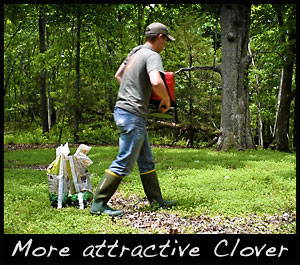Fall Time Clover Management
Filed under: Food Plots, Hunting Blog
Last week we discussed fall food plots and the specifics of how planting a mixture can serve as a time released food plot during hunting season. Having an attractive food source throughout the season is important to holding deer on your property.
 Continuing the theme of food plots, this week is all about fall time clover management. If you have clover plots, then you have most likely experienced the struggle to keep them weed free. Herbicide applications can be ineffective during certain stages of weed growth. Mowing can be time consuming as multiple mowings may be needed. To limit the amount of weed growth in our plots we plant a cover crop of Monster Wheat right into our stand of clover each fall.
Continuing the theme of food plots, this week is all about fall time clover management. If you have clover plots, then you have most likely experienced the struggle to keep them weed free. Herbicide applications can be ineffective during certain stages of weed growth. Mowing can be time consuming as multiple mowings may be needed. To limit the amount of weed growth in our plots we plant a cover crop of Monster Wheat right into our stand of clover each fall.
Clover is a legume; this is a fancy term meaning it fixates nitrogen and returns it into the soil. The excess nitrogen that clover does not use is often taken advantage of by noxious weeds. This is why weeds can be so prevalent in stands of clover. Weeds are most present in clover plots when the clover is dormant. During the fall the wheat takes advantage of the nitrogen produced by the clover, instead of the weeds doing so the following spring . In addition, wheat is another great forage for deer that provides an additional attractant to a food plot.
During the following spring the wheat will grow and produce a head. During certain stages of maturation, the wheat head is highly sought after by both deer and turkeys. By planting a cover crop of wheat the excess nitrogen is used to benefit your plots health and increase the amount of forage available to the local deer herd. This is a win-win for deer hunters and managers. Fight weeds by planting more food for deer!
GrowingDeer together,
Matt



